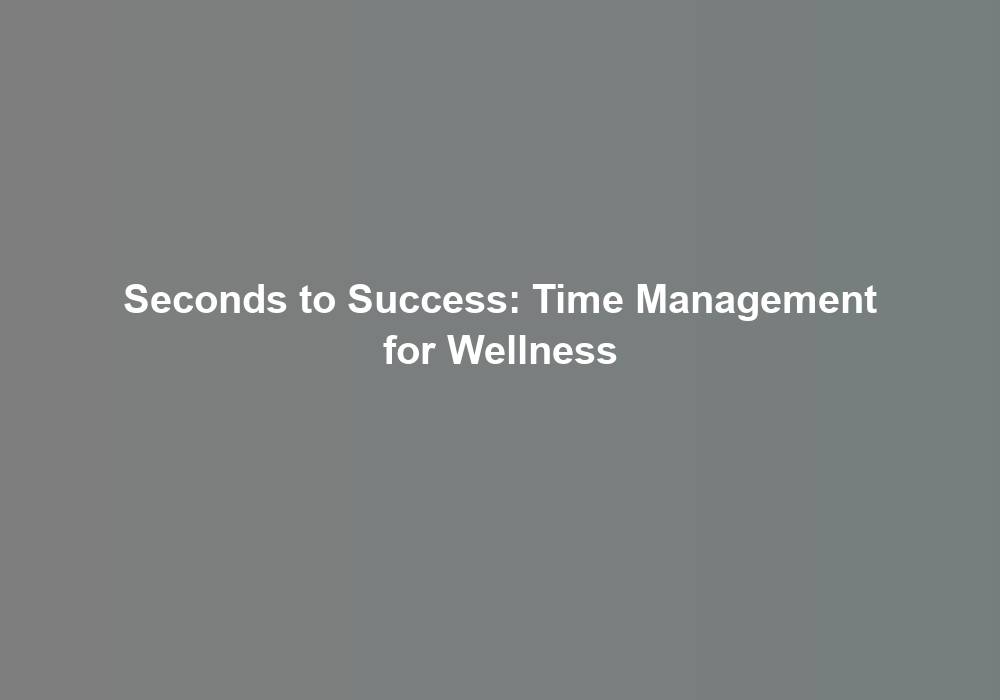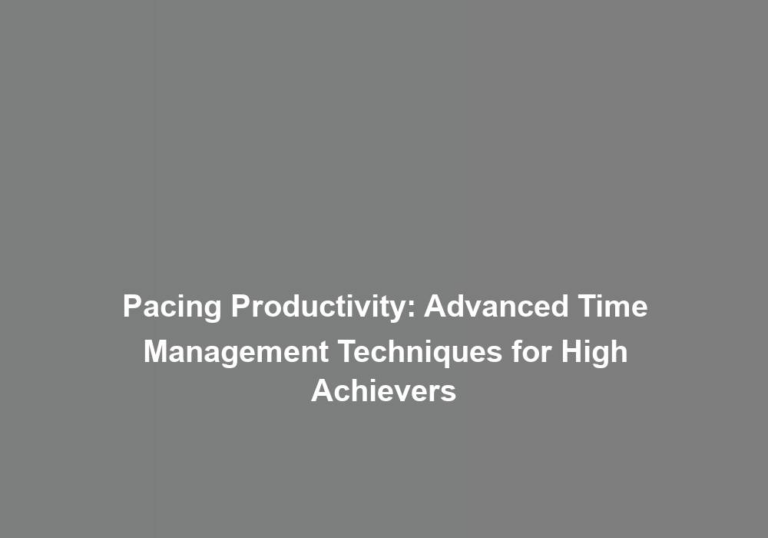Seconds to Success: Time Management for Wellness
Struggling to strike a balance between your professional and personal pursuits? In todayG??s fast-paced world, time management plays a pivotal role in your overall wellness. But how can you navigate the complexities of time to achieve both success and serenity? LetG??s explore some practical strategies that can help you reclaim control of your schedule and unlock the key to a more harmonious lifestyle.
The Impact of Time Management on Wellness
If you consistently practice effective time management, you can significantly improve your overall wellness and reduce stress. Mindful planning and organizing your tasks can have a profound impact on your stress levels. When you manage your time well, you are more likely to feel in control of your day, leading to a reduction in stress and anxiety. By setting realistic goals and prioritizing tasks, you can approach your day with a sense of purpose and direction, reducing the likelihood of feeling overwhelmed. Additionally, effective time management allows you to create space for leisure activities, hobbies, and socializing, which are all important aspects of wellness.
Mindful planning also helps to prevent the accumulation of tasks, which can lead to last-minute rushes and increased stress. When you allocate specific time slots for different activities and commit to sticking to these schedules, you can avoid the frantic scramble to complete tasks. This approach fosters a sense of calm and control, contributing to reduced stress levels. Furthermore, by managing your time effectively, you can allocate dedicated periods for relaxation and self-care, which are essential for maintaining overall wellness.
Identifying Time Wasters and Prioritizing Tasks
When striving to enhance your time management skills for wellness, itG??s crucial to identify time wasters and prioritize tasks effectively. One effective way to identify time wasters is by conducting a time audit. Take a week to track how you spend your time. Note every activity, no matter how small, and be honest with yourself. At the end of the week, review your time log. Identify activities that consumed a significant amount of time without contributing to your productivity or well-being. These are your time wasters. Once youG??ve identified them, brainstorm ways to minimize or eliminate these activities from your routine.
After identifying time wasters, the next step is to prioritize tasks. Start by listing all your tasks and responsibilities. Then, rank them based on their importance and urgency. Use a system that works for you, such as a simple numbering system or color-coding. This process will help you focus your time and energy on tasks that truly matter. Remember, not all tasks are created equal. By prioritizing effectively, you can ensure that you invest your time in activities that align with your wellness goals.
Effective Scheduling for Work-Life Balance
To achieve work-life balance, prioritize your tasks and commitments and then schedule them in a way that allows for flexibility and boundaries. One effective scheduling technique is time blocking. This involves setting aside specific blocks of time for different activities or types of work. By doing this, you can ensure that you allocate time for both work and personal activities, helping to maintain a healthy balance between the two.
When implementing time blocking, consider your energy levels throughout the day. Energy management is crucial for effective scheduling. For example, if you tend to have higher energy levels in the morning, schedule your most demanding work tasks during that time. Save less demanding tasks or activities that require less mental focus for periods when your energy naturally dips. By aligning your schedule with your energy levels, you can optimize your productivity and ensure that you have time for relaxation and personal activities.
ItG??s important to be flexible within your time blocks. Unexpected events or tasks may arise, so having some flexibility within your schedule can help accommodate these changes without causing undue stress. Additionally, setting boundaries around your time blocks is essential for work-life balance. Clearly communicate your availability to others and protect the time youG??ve allocated for personal activities to maintain a healthy balance between work and life.
Strategies for Maximizing Productivity
Maximize your productivity by setting specific goals and breaking them down into manageable tasks to maintain focus and momentum. One effective strategy is task batching, where you group similar activities together to minimize transition time and mental effort. For example, designate specific times for checking emails, making phone calls, or conducting research. This approach helps you avoid context switching and enhances efficiency.
Another key strategy is time blocking, which involves allocating specific time slots for different tasks or types of work. By doing this, you create dedicated periods for focused work, meetings, and personal activities. This not only helps in accomplishing important tasks but also ensures that you allocate time for personal well-being and relaxation.
Energy management is crucial for maximizing productivity. Identify your peak energy hours and schedule your most challenging or important tasks during these times. Use focus techniques such as the Pomodoro method, where you work for a set period, typically 25 minutes, and then take a short break. This approach can help sustain concentration and prevent burnout.
Incorporating these strategies into your daily routine can significantly enhance your productivity and overall well-being. By managing your time effectively, utilizing energy management techniques, and implementing task batching and time blocking, you can create a balanced and focused approach to work and life.
Cultivating Self-Care Habits Within Daily Routines
To build on the strategies for maximizing productivity, itG??s important to integrate self-care habits into your daily routines for overall wellness. Daily rituals play a crucial role in nurturing self-care habits. Start by setting aside specific times for self-reflection and mindfulness. Take a few minutes each morning or evening to check in with yourself, assess your feelings, and set intentions for the day or unwind from it. This simple practice can help you stay connected with your emotions and reduce stress.
Time blocking is another effective way to cultivate self-care habits within your daily routine. Allocate dedicated time slots for activities that rejuvenate you, whether itG??s reading, exercising, or spending quality time with loved ones. By consciously prioritizing self-care in your schedule, you ensure that it doesnG??t get overshadowed by other tasks.
Energy management is vital for maintaining self-care habits. Pay attention to your energy levels throughout the day and adjust your activities accordingly. If you notice that youG??re most energetic in the morning, consider scheduling your self-care practices during this time to maximize their impact.
Incorporating self-care habits into your daily routines doesnG??t have to be complicated. By embracing daily rituals, practicing self-reflection and mindfulness, using time blocking, and managing your energy effectively, you can create a sustainable foundation for holistic wellness.
Conclusion
YouG??ve learned how to reclaim your time and prioritize your wellness. By identifying time wasters and implementing effective scheduling, you can achieve a work-life balance that promotes productivity and self-care. ItG??s time to say goodbye to procrastination and hello to success. With these practical strategies, you can transform your daily routines and maximize your potential. ItG??s all about making the most of every second for a healthier, happier you.







